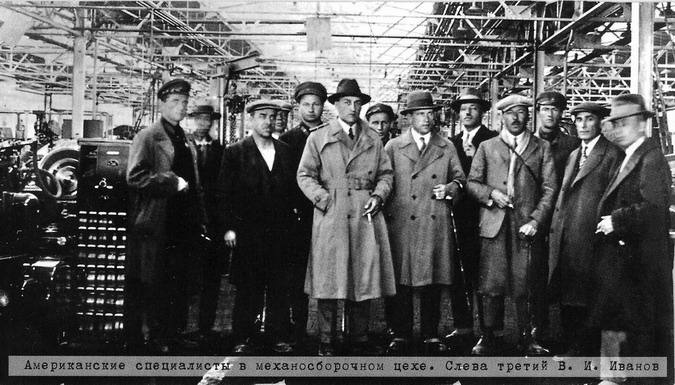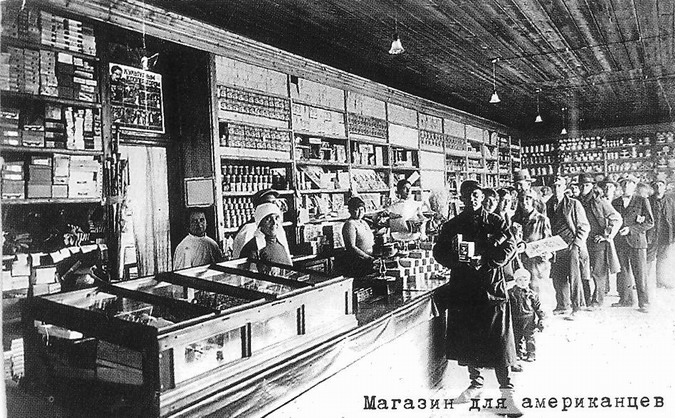American colony at the Stalingrad Tractor Plant
STALINGRAD, STALINGRAD
Specialists from Detroit were recruited to launch the Stalingrad Tractor Plant, built according to the project of the American company Albert Kahn Incorporated and equipped with American equipment. There, on Congress Street, a representative office of Traktorostroy was opened to recruit those wishing to go to Stalingrad. At the final stage, all work on ordering equipment and hiring people was coordinated by the first director of STZ, V.I. Ivanov, who visited one of the largest industrialists of the USA, Henry Ford and secured consent to recruit three hundred of his workers.
In the spring of 1930, groups of Americans began arriving at STZ, some with their families. They were housed in the new houses of the lower settlement of the plant. The rooms were furnished. There was a restaurant for foreigners, an Insnab store, a doctor's office. Americans, as guests, were given maximum attention at work and in everyday life: a somewhat lighter work schedule, lectures, concerts, movies, dancing to jazz. It was published for the newspaper "Give a tractor!" application in English "Spark of Industry". The workers were the Americans themselves.

This is how the most populous American colony in the USSR, of 370 people, settled in our country. To resolve the numerous issues that inevitably arise in a foreign country for them, and to communicate with the administration of the plant by secret ballot, a chairman and a secretary were elected, who directed the entire life of the colony. About seventy twenty-year-old girls were involved in translations. Most of them did not have sufficient knowledge in the field of technology, production technology and sufficient skills in colloquial speech, so at the beginning there were many ridiculous mistakes in the work of translators. There was a case when, due to an incorrect translation in the foundry, an irreparable marriage turned out. The translators had to urgently master the technical terminology. It soon turned out that in such a purely everyday matter as eating, one cannot do without translators. Americans gathered at their restaurant three or more times a day. Constant misunderstandings and even clashes with the service staff, who did not understand the foreigners at all, and they, in turn, did not understand the staff, led one day to an unpleasant incident: one of the Americans threw a plate of hot soup right in the face of our waiter. After this incident, the translators were asked to eat with foreigners, translate and keep order in the restaurant.

Americans could be roughly divided into three categories of people:
1. Highly qualified specialists belonged to the largest in number. They themselves worked conscientiously and honestly passed on their experience and knowledge to the Soviet workers. For their excellent work, the Americans Svajan and Khoney were awarded the Orders of Lenin. Good specialists from among foreigners were appointed heads of shops, foremen. From among the shock workers in January 1931, three Americans were elected as candidates for deputies and deputies to the city council, and seven Americans to the district council. One candidate was challenged because he had hired workers on his farm, i.e. was by those concepts an exploiter. Americans also joined the Communist Party, including Americans of Russian descent.
2. The second, much smaller, category included the Americans conscientiously fulfilling their obligations under the contract. They felt they were obliged to work honestly for the wages they received in dollars. But they did not engage in what was called social work in the USSR, did not speak out on production and socio-political issues.
3. The smallest category included those Americans with whom contracts had to be terminated ahead of schedule for absenteeism and drunkenness and who with poor performance were sent back to the USA. Two Americans were sentenced to expulsion from the USSR for a racial trick in relation to a specialist - a Negro by nationality.
Just as the foreign colony was not homogeneous on a national basis (there were people here from Germany, Sweden, Italy and even from the island of Jamaica), so it was not homogeneous in terms of convictions among the colonists. Already in May-June 1930, the American Committee was created. It included anti-Soviet Americans. They were not going to help start up the plant and spread rumors among the Russian workers that the venture with the plant would surely fail. Members of the American Committee went on strike if, for example, there were no groceries or cigarettes in Insnab's store. The opposite in its direction was the organization of the CultTechPossibility of the USSR. Its members deliberately helped the Soviet people in mastering the latest equipment and called on the rest of the Americans to help start the STZ conveyor faster. It was these Americans who were awarded certificates of honor and valuable gifts on June 17, the day the plant was launched. The American Committee hated the members of the KTP of the USSR and often fought with them. but so that the Soviet people did not see this enmity.
The year of the Americans' work at STZ passed quickly. They had to go home. The management of the plant decided to extend the contracts with a small group of specialists for another year. Workshops applied for, selecting the best and necessary specialists. Negotiations with the Americans have begun. On this occasion, great excitement began in the American colony, replaced by anxious expectation. Nobody wanted to go home - there is unemployment. Therefore, they agreed to work not for currency, but for rubles. One by one, the Americans were summoned to the director of the plant, declared by the shops. They entered the office with ill-concealed excitement. Leaving the director's office, these lucky ones, as their fellow countrymen called them, regained their important appearance. Everything went well for them, another year of work was secured. For the rest of the foreigners, the foreign department of the plant hastily prepared a calculation. visas, characteristics.
The day of departure came. The American restaurant was packed with people. The presidium includes representatives of the management, party and trade union organizations, the best American workers. Everyone wanted to say at least a couple of words at parting. The Americans thanked the Russians, the Russians expressed their gratitude to the Americans in return. Some specialists by their firms were sent to the construction of the Kharkov and Chelyabinsk tractor plants. Those who left for the United States wrote letters to the plant with a request to allow them to come to the STZ again. Several Americans, having adopted Soviet citizenship, remained in our country forever.
